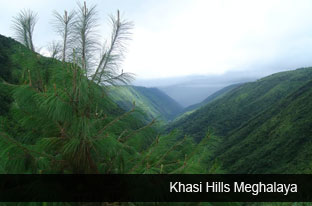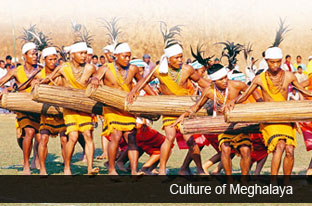
Capital – Shillong ~>> Area - 22,429 sq km ~>> Language – Meitei, English, Thado, Tangkhul, Kabui, Paite, Nepali, Hmar, Vaiphei and Liangmei
 Mostly visited for – Shillong (the capital city of Meghalaya and Gleneagle of the East famous for golfing), Mawsynram (the record holding wettest place on the earth), Cherrapunjee (the second wettest place on the earth), Jakrem (curative hot water springs), Tura, Nongstoin, Jaintai Hills, Khasi Hills, Mawphiang, Nartiang, Botanical Survey of India Orchardium, Dawki, Umngot Creek, Pamsutia Canyon
Mostly visited for – Shillong (the capital city of Meghalaya and Gleneagle of the East famous for golfing), Mawsynram (the record holding wettest place on the earth), Cherrapunjee (the second wettest place on the earth), Jakrem (curative hot water springs), Tura, Nongstoin, Jaintai Hills, Khasi Hills, Mawphiang, Nartiang, Botanical Survey of India Orchardium, Dawki, Umngot Creek, Pamsutia Canyon
Adventure – Trekking, Boating, River Rafting, Angling, Golfing
Major Cities – Imphal, Churachandpur, Bishnupur, Ukhrul, etc
Weather - Summer: March to May, Monsoon: June to September, Post Monsoon: October to November, Winter: December to February. Climate of Meghalaya depends upon the altitude of hill ranges and varies from tropical to sub-alpine.
Connectivity
By Air - Meghalaya has the only airport near Umiam Lake near Shillong. Umiam is 30 km from Shillong and a 1 hr. drive. There is a regular helicopter service between Guwahati and Shillong. Six days operation of ATR from Kolkata to Shillong except Friday.
By Rail - The state does not have any train service. The nearest railway station is in Guwahati.
By Road - Road Network in the state is quite efficient and coves the state conveniently. National Highway 40 is an all-weather road running through the state. The road connects Shillong with Guwahati, which in turn is connected to other major cities in the rest of the country.
History, Geography and Culture of Meghalaya
The land of the rain clouds, Meghalaya is the rain capital of India. Most of the year, it rains in Meghalaya, providing bountiful backdrop for flora and fauna to flourish. Dwelled by the oldest living immigrants or Khasis, Jaintias and Garos as separated kingdoms, this isolated state saw the integration under the British administration in 19th century. In this culminating process, the British brought the territory under Meghalaya into Assam in 1835. Post independence, Meghalaya got the autonomy within Assam. But Meghalayans in an aspiration of a separate state started a peaceful struggle. As a result of this, Meghalaya got a status of statehood in the Republic of India during the year 1972.

This young state of India is known for geographical gems that have added on to the attractions of Meghalaya. Geographically, the state is based upon a rocky Meghalayan plateau featuring Archean rock formations of rich mineral deposits of coal, limestone uranium, etc. Located at an elevation of 2000 m, the state’s charming blue hills are covered with dense rainforests and variety of orchids. The weather of the state is moderate, but humid most of the times. Due to its location close to the Bay of Bengal, the state receives maximum rainfall and is among the wettest place on planet earth. Cherrapunjee and Mawsynram in Meghalaya are the rainy destinations of this state. Other geographical attractions of this state include gushing waterfalls, deep gorges, caves and living root bridges.
Made from the roots of ficus elastica tree, these living root bridges are a legacy of Meghalayas past that is continually a part of this state’s natural heritage. The flora and fauna of this thickly forested state is equally enriching. Two of Meghalaya’s national parks, the Nokrek and Balpakram, serve as a home to some of the rare wildlife species such as the golden cat. Other faunal attractions of the state are elephants, bear, civet, mongoose, wild buffalo, deer, wild boar, etc. Siju, another wildlife sanctuary here is famous for Dobakkol or the bats and cave with impressive stalagmites and stalactites.
This magical state is also known as orchid country with about 300 of the world’s species growing in its rich forests, gardens and nurseries.The Wealth of Meghalaya’s exotic butterflies and moth species found in its forests and meadows have been showcased in the delightful Butterfly Museum.
Culture of Meghalaya is tribal in nature. The main tribes here are the Khasis, the Garos and the Jaintias. Majority of Meghalaya’s population follows matrilineal culture where lineage and legacy of ancestry is traced through women.
Wildlife Sanctuaries
Balpakram Wildlife Sanctuary, Nokrek Biosphere Reserve (Garo Hills district), Siju Cave
Religion – Christianity, Hinduism, Islam, Sikhism, Jainism, Buddhist
Festivals
Shad Suk Mynsiem (Apr)
Behdienkhlam (July)
The Laho Dance Festival (July)
Chambil Mesara or Pomelo Dance Festival (Oct)
Nongkrem Dance Festival (Nov)
Wangala (Nov to Dec)
Doregata Dance Festival
Eat – Pork, Nakham Bitchi (Soup), Preserved Fish/ Meat, Jadoh, Jastem, Mylliem chicken, Dohkhlieh, Dohneiiong, Tungrymbai, Pumaloi, Puklein, Pudoh
Buy – Weaving, Metal Works, Wood and Stone Carving, Basketry
